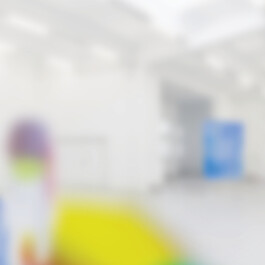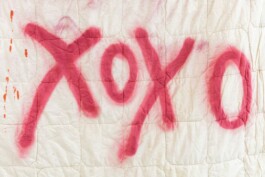Interview mit
Silke Berg
Silke Berg studied painting at Leipzig Academy of Visual Arts with Professor Michael Riedel and Professor Ingo Meller as well as in Copenhagen. She lives and works in Leipzig. In 2019, she won the Kultur rockt prize of the cultural department of the Landschaftsverband Westfalen-Lippe (LWL) and the LWL Museum of Art and Culture. Her works were displayed in 2021 and and shortly before dismantling the exhibition, there was still time to briefly engage in dialogue and ask Silke a few more questions.
The Artist, Silke Berg

Silke Berg, Artist Talk
Tanja Heuchele: Your life without art would be….
Silke Berg: That’s a difficult question, because art means a lot in my life. I think I would probably be a little less happy. But in fact, I can hardly imagine my life without art.
TH: The working title of the exhibition is “Kontingenz und Malerei” (“Contingency and Painting”). What does contingency mean to you in your artistic practice?
SB: It means that in my artistic practice, I always move in a field of many decisions and possibilities. In this field, I make decisions, e.g. based on a colour, form, or idea in order to develop or expand a work from it. I usually work rather spontaneously and during the artistic process, I often react to colour surfaces or forms, which I have already painted. There is usually a rough sketch for the individual pieces. However, the artworks always develop in the process, within the spectrum of many possibilities and decisions.
TH: Which places or situations were a source of inspiration for the exhibited works?
SB: Currently, an important source of inspiration in my work is outdoor equipment, or functional clothing and equipment for “being outside”, so to speak. Many of the exhibited sculptures contain parts that are used for backpacks, tents or skydiving.
TH: You completed your diploma at the Academy of Visual Arts with Ingo Meller and Michael Riedel in Painting and Painting and Graphics Classes. The works you are showing in the exhibition interact with the space as colourful three-dimensional objects and contrast with the works of the other artists, who remain true to the classical place of painting, the canvas or two-dimensionality. Have you always worked in this form or did you develop it in the course of your work from painting or from another field?
SB: In the first years of my studies I did rather “classical” (two-dimensional) painting and also very large-format drawings. In the course of my studies, however, I felt the need to bring the painting and the abstract forms that I drew and painted at that time into the space and that’s why I started experimenting with canvas. I still see some of my works as paintings, because in most cases they always consist of painted surfaces. But my painting has simply moved into a sculptural field and that’s why the terms swing back and forth for me.
TH: What role does fashion play in your work?
SB: I have worked a lot with “clothing as a work of art”. Fashion itself doesn’t play a very big role in my work, but the relationship between body and artwork does. In addition, the question of how a person can interact with a work of art is something that continues to occupy me a lot artistically.
Silke Berg, Exhibition View, 2021

Silke Berg, Artist Talk
TH: Your works, with their placements, evoke associations with seating as well as, through the shapes or also through cords and buckles, with outdoor equipment. Does inspiration come to you more through rest or activity?
SB: My inspiration comes at different moments. Therefore, it is difficult to say that it happens either through rest or through activity. I would rather say that I find my sources of inspiration for the works through emotions, fascinations, or simply small details in my surroundings or shapes that catch my eye which I want to bring into the works.
TH: Why do you paint the fabric for your works instead of just using fabric in the corresponding colour?
SB: Painting is an important moment in my working process. It is here that the first forms and colour decisions are made, which then influence the further process of the works. The works actually often contain a mix of painted textiles and other bought and already dyed textiles. But I also see these pre-dyed and bought textiles as a kind of painting palette with which I can work on the same white level as with painting.
TH: What kind of filling material do you use in your work?
SB: At the moment it is often corn chips or polyester fleece. But I am actually looking for other filling materials…
TH: Now we look at your work: “es scheint so” (it seems so). Now what seems so?
SB: The title of this work plays with an allusion to an apparent activity or usability of the sculpture. For me, the work relates to the lake and the shape of a buoy. In any case, that is why the work has been given this title. But what visitors of the exhibition associate with the work and its title is of course left open to everyone.
Silke Berg, Exhibition View, 2021

Silke Berg, Artist Talk
TH: What do you wish for the time “after” Corona in the context of the exhibition?
SB: For me personally, it is very important to look at art in real life, because I find many haptic and beautiful moments of art are lost in the digital space.
TH: What does good art mean to you?
SB: For me, good art is something I can experience, know and feel. Something that touches me or makes me think.
TH: Your next projects, exhibitions. Where can we see you next?
SB: At the moment you can see my work in the exhibition “This Is Not Funny” at Kunstverein Tiergarten / Galerie Nord in Berlin. It’s running until 7th of August 2021.
Silke Berg, Exhibition View, 2021

Siehe auch
Mehr Interviews



